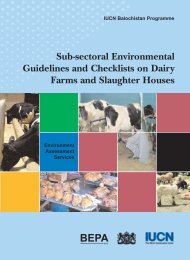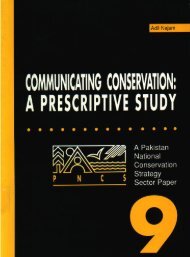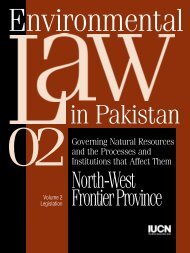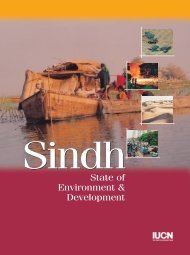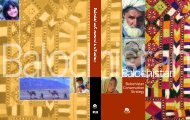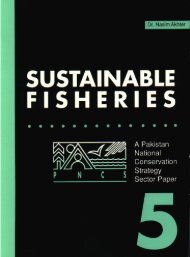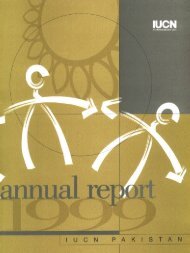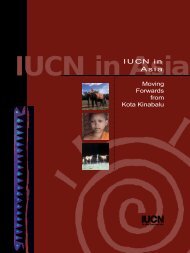Nigel JR Allan - IUCN - Pakistan
Nigel JR Allan - IUCN - Pakistan
Nigel JR Allan - IUCN - Pakistan
Create successful ePaper yourself
Turn your PDF publications into a flip-book with our unique Google optimized e-Paper software.
8<br />
ditions. Issues of the Alpine Journal and the Himalayan Journal over the past<br />
two decades, since these mountains were reopened for mountain climbing,<br />
will bring the readers up to date on these activities. There are also<br />
large numbers of books written by the modern climbing fraternity about<br />
their exploits. All of this literature has a Eurocentric view and contributes<br />
little to our knowledge of habitat and society in the Karakorum. There is,<br />
of course, the occasional exception, like the contributions of Wilhelm Kick<br />
over the years who brought to our attention the scientific contributions of<br />
the Schlagintweit brothers of last century.<br />
Another issue at the forefront is the accommodation for large numbers<br />
of tourists in this region. In Ladakh several Airbus 320 flights arrive each<br />
day during the tourist season, principally summer because it is dry, and<br />
they are accommodated in over 100 hotels of variable quality in Leh. In<br />
addition, the conflict in the Vale of Kashmir has not interrupted the flow of<br />
tourists because the overland tourists now travel by bus from Manali in<br />
Himachal Pradesh over several 5000m passes to the Indus valley and then<br />
downstream to Leh. The Karakorum mountains in Gilgit and Baltistan have<br />
yet to experience a fraction of this tourist load on their facilities. The number,<br />
however, is rising and within the past two years the Aga Khan Foundation<br />
has given program assistance to Gilgit villagers in developing simple,<br />
hygienic overnight accommodation for foreign tourists. Among Himalayan<br />
countries <strong>Pakistan</strong> has taken the lead in setting a fixed rate and schedule of<br />
payments for using porters in the high country.<br />
In this century, the Karakorum mountain literature has been dominated<br />
by climbing accounts. Many of these are covered in Dorothy Middleton’s<br />
introduction to the Miller (1983) books on a surveying expedition to the<br />
Karakorum celebrating the 150th anniversary of the Royal Geographical<br />
Society. The dominant theme of these and similar volumes is the jaded<br />
view of Europeans looking at local culture. On some occasions, these views<br />
border on racism as seen in the four books and twenty-three articles written<br />
by Reginald Schomberg that I managed to unearth at the library of the<br />
Royal Geographical Society. The authors were products of their day, as<br />
Schomberg was, and his views may seem more understandable in the context<br />
of his time, but similar views of indigenous people, Fourth World people<br />
as some would have it, regrettably remain in many contemporary books<br />
on expeditions to the Karakorum. A reader of the Karakorum literature<br />
need only consult the products of two prominent mountain photographers,<br />
one American and the other Japanese, to discern the bigoted gaze by the<br />
First World elite of the indigenous inhabitants. Butz and MacDonald have<br />
done much to sensitize us to these distorted views, not only of Europeans<br />
but those exhibited by Indians and <strong>Pakistan</strong>is from the urbanized plains.<br />
For the Karakorum territory not at the eastern end, essentially encompassing<br />
Baltistan and Gilgit, I have included a substantial amount of “grey”




